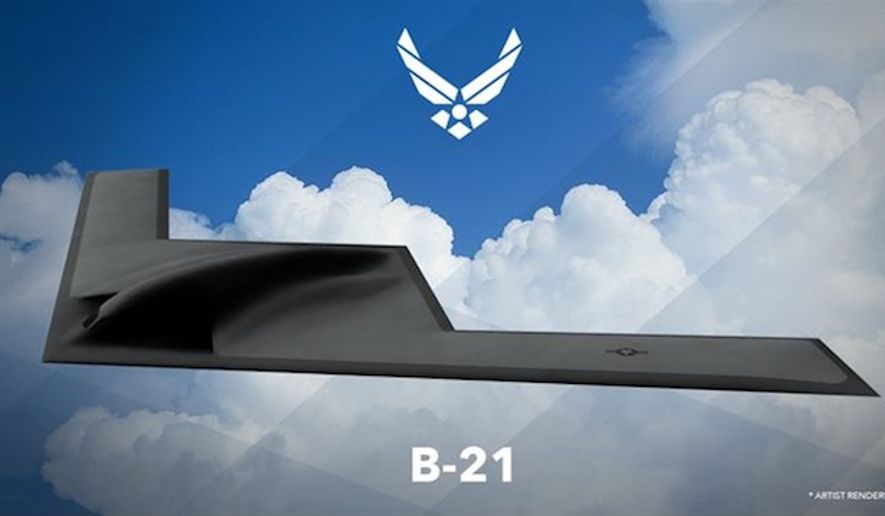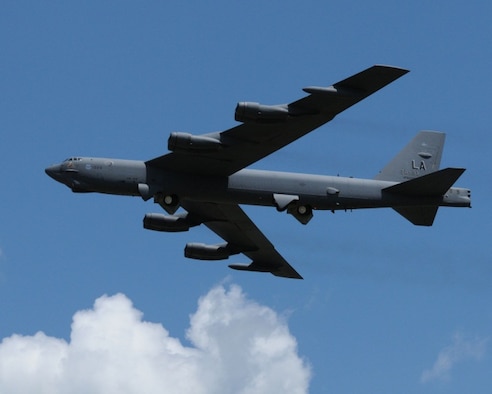Bomber 21? Why Not Build a Better B-52?
By Scott Spangler on February 29th, 2016 The U.S. Air Force opened the doors on its new, and as yet unnamed, long-range strike bomber, the B-21. The contract pasted in the cockpit window said each bomber would cost $500 million and the total program cost for a fleet of 100 B-21s would be $80 billion. Yeah, like that will happen.
The U.S. Air Force opened the doors on its new, and as yet unnamed, long-range strike bomber, the B-21. The contract pasted in the cockpit window said each bomber would cost $500 million and the total program cost for a fleet of 100 B-21s would be $80 billion. Yeah, like that will happen.
Given the tradition of cost overruns and schedule delays, we can expect only two things with any certainty. First, the bomber will succeed the F-35 as the nation’s most expensive weapons program, and it will guaranteed a century of service for the B-52.
Like all the bombers that have come since B-52 entered service in 1955, the B-21 is supposed to replace the heavy-hauling daily driver of the bomber fleet. Brought to you by the same company that delivered the B-2 Spirit at $1.157 billion each, the B-21 will likely become another pampered plane, a winged Lamborghini, that only comes out of the garage when it’s a nice day.
If the Air Force is going to make a “better” B-2 with the B-21, why not get more for the taxpayer’s money by building a better B-52 by following the precedent set by the P-8 Poseidon, based on the Boeing 737, and the KC-46 Pegasus, based on the Boeing 767. Why call up the computer design files for the Boeing 787-9 Dreamliner and save them as the foundation for the new B-52? Given their sticker prices, we could get two for the price of one, at least until the “military discount” increases the 787’s price.
Comparing the available specs for the B-52 and 787, there seems to be a lot of opportunity. The B-52 can lift 70,000 pounds of ordinance as part of its 488,000-pound maximum takeoff weight and carry it 8,800 miles. The B-2 has a 40,000-pound ordinance capacity, a 336,500-pound max takeoff weight, and 6,897-mile legs without refueling.
 Naturally, there’s no ordinance spec for the 787-9, so let’s extrapolate. It will carry 280 passengers, so that 47,600 pounds at 170 pounds a piece. Then there is their baggage and those overstuffed overhead compartments. (Maybe an airline-savvy reader can share how the airlines compute this weight). Without refueling, the 787-9 will carry this load 7,635 miles. The point is, with a 280,000-pound useful load, there seems to be possibilities with the airframe.
Naturally, there’s no ordinance spec for the 787-9, so let’s extrapolate. It will carry 280 passengers, so that 47,600 pounds at 170 pounds a piece. Then there is their baggage and those overstuffed overhead compartments. (Maybe an airline-savvy reader can share how the airlines compute this weight). Without refueling, the 787-9 will carry this load 7,635 miles. The point is, with a 280,000-pound useful load, there seems to be possibilities with the airframe.
And let’s not forget its fuel-efficient operation. As a bonus, the Air Force could forward deploy the B-787 to any commercial airport that now welcomes the airplane. It would not only same time, money, and fuel, it would drastically reduce the safety risks involved with the multiple midair refuelings—and pilot fatigue—that are the hallmark of B-2 missions that start and end at Whiteman Air Force Base in the middle of Missouri.
The B-bombers’ stealth capabilities seems an overpriced luxury these days. In unveiling the B-21, the Air Force implied it was essential to survive a “high threat environment.” Let’s get real. Vietnam was the last time U.S. bombers flew into a high threat environment. And as far as I know, that was the last conflict in which an American bomber, the workhorse B-52, was shot down.
Given the economic and electoral consequences of conflict among the major players in the global economy, it seems unlikely that we’ll ever again see a cold war-era high threat environment. As the past 15 years have proven, the highest threat comes from an unknown individual with a backpack bomb and AK-47, and stealth tech will not protect us from that. Better to have a heavy hauler loaded with precision-guided munitions and enough gas to let it loiter for a long time.
And as I conclude my rant, I have one more question. Since September 18, 1962, the U.S. military has used the same sequential aircraft designation system. B is for bomber, so how do we go from the B-2 to the B-21? Asking Google about B-3, Wikipedia identified it as the long range strike platform seems to be the B-21.
B-3 also identified Army Air Corps biplane bomber, the Keystone, from the 1920s. But searching all the B’s thereafter revealed no new bombers of this century between the two. There was a BAT 21, but that’s a totally different story from another time now long past, when the B-52 was supposedly counting its final missions. – Scott Spangler, Editor
Related Posts:








February 29th, 2016 at 7:49 pm
I welcome the idea of saving tax dollars but stealth technology a “luxury?”
Not if it was my butt in the cockpit.
Our servicemen deserve the best protection we can provide, period. Not the most economical.
February 29th, 2016 at 10:04 pm
Scott:
Great article� however, I think the folks flying bombers in the conflicts since Vietnam might argue with your sentence �Let�s get real. Vietnam was the last time U.S. bombers flew into a high threat environment.�
I really believe these guys and gals that have been flying around war zones while being shot at would take exception. Let�s not minimize their risk or threat to their aircraft.
Keep up the great work. I really enjoy reading your pieces.
Safe Flying,
Brian
February 29th, 2016 at 10:07 pm
How about max taxi minus zero fuel weight for a green 787- whatever airframe?
You can use that number for fuel or bombs taking into consideration any vagueries of landing weight restrictions.
Yes, the taxpayers or my unborn grand children’s billfold or pocket book is always fair game in the interest of national security.
Jim
March 1st, 2016 at 11:17 am
Scott,
You need a reality check. BOMBERS create airliners airliners don’t become bombers. Some history Boeing 307 built from the B-17. The Boeing 377 was based on the KC-97 which was an outgrowth of the B-29. The 707 used the designs of the B-47. And as a subgroup the only reason the 747 exists is to meet the specification for C-X which it lost to the C-5.
As for your comment about contested airspace. We had a small little war 25 years ago called Desert Storm. Who’s air defenses were substantially more intense then North Vietnam. Likewise now that the Russian have deployed to Syria, that also could be considered contested airspace.
B-2s have been flying strikes over Libya, Afghanistan, Iraq. Their ability to fly long range missions is their advantage not a liability. The crews train for LONG endurance missions. That is all part of the B-2 survivability.
Your presumption that its a good idea to be able to forward base a strategic bomber at any international airport is just wrong! You want to control the area around your platforms. You just don’t pull a bomber up to a gate!
The B-2s uses GPS munitions and can take out multiple targets. They took out airfields in Libya so there was no contested airspace.
Lastly your implied assumption that you just stick a boom on a 767 and get a tanker and throw some torpedoes in a 737 to get a P-8 is just faulty. They are both new airplanes, if that wasn’t the case Boeing wouldn’t have need to completely rewire the first KC-46As.
Besides I personally wouldn’t want a 787-9 carrying a B-61 nuclear bomb in a bay that is next to overheating Lithium Ion Batteries that catch fire parked at my local International Airport.
Rant over!
March 3rd, 2016 at 1:29 am
[…] Bomber 21? Why Not Build a Better B-52? […]
March 7th, 2016 at 10:21 am
The prototype for the KC-135 is the B-377 Dash 80. The idea was to have a tanker that matched performance of the bomber it was tanking. Since Boeing was building the B-48 at the time and just developing the B-52 they knew what performance the tanker should have. Using $16M of their own money Boeing built Dash 80, showed it to the Air Force and had a contract in a month or so for the KC-135. The $16M was either risk capital well invested; recovered in allowable charges on government contracts; paid back by all the Boeing 707s sold; money that would have had to be paid to Uncle Sam as Korean War era excess profits taxes anyway or some combination of the above.
Dash 80 is a one off development article that spent the rest of it’s 3,000 or so hours in the air developing thrust reversers, aerodynamic improvements to wings, engine development (original had JT-3s and took a mile of runway to operate)and high lift transport wings with blown flaps and such.
Real KC-135s and it’s numerous derivatives are not B-707s and have so many differences they might as well be totally different aircraft, though they are similar from an aerodynamic and systems standpoint.
U.S. type certificated aircraft and military aircraft are totally different animals from a regulatory point of view, though they obviously must hew to the same laws of physics. Stating that a such and such certificated aircraft just has a weapons bay or 2 added, MAD boom, shorter/longer fuselage, different engines, different weight and balance, but other than that is the same as the certificated aircraft so you save all that testing is very creative. Going the other way the neatest situation I know of was in the 1980’s there was no U.S. type certification basis for airships (i.e. blimps). The Goodyear blimps were allowed on the basis of their derivation/close design similarity with the blimps built by Goodyear for the Navy during WW II that flew gazillions of hours without design problems thus demonstrating the design empirically. This came to light at the higher management levels when various other companies from Europe and elsewhere wanted to build lighter than air ships for commercial operations which, of course, had to be type certified. But there is no basis. Well, reverse engineer the basis. Quickly.
March 11th, 2016 at 8:54 pm
Keeping the bomber program highly classified may help save it from being axed due to competing priorities with overlapping capabilities, but that tactic can only last so long before it kills the bomber itself.